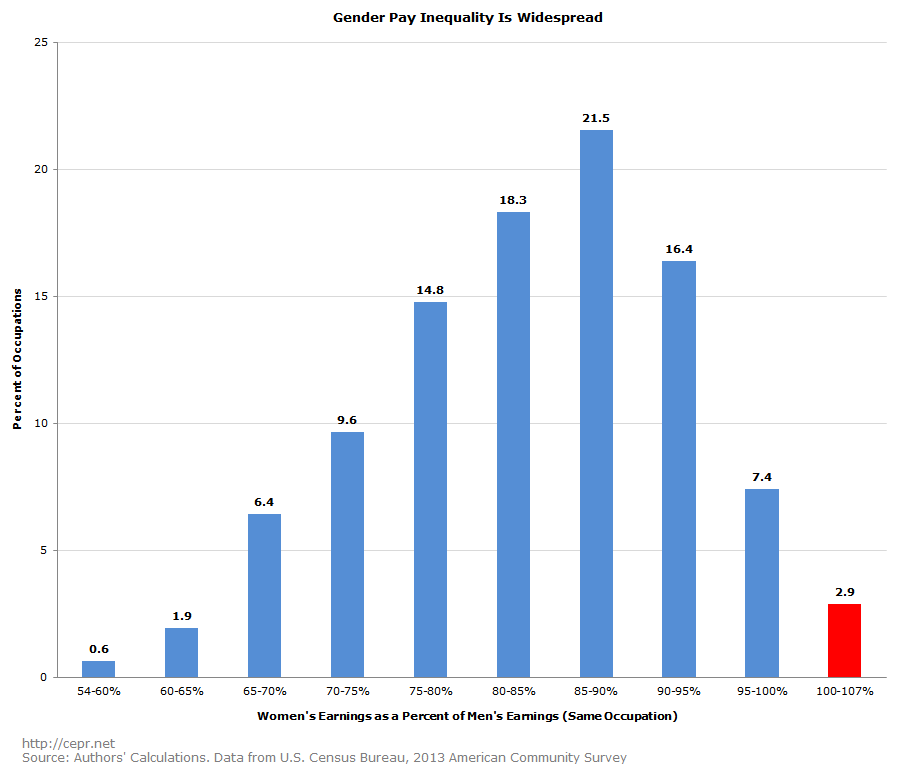October 05, 2015
In his 2014 State of the Union address, President Obama discussed the fact that women workers are paid far less than their male colleagues: “That is wrong. And in 2014, it’s an embarrassment. Women deserve equal pay for equal work!”
Some commentators have criticized President Obama’s statement, arguing that the gender pay gap doesn’t account for occupational choices or differences in hours worked. Consider the critique about occupational choices: if women choose to work in low-paying occupations, a substantial gender pay gap can exist even if women are paid the same as men in every occupation. If this is true, we can’t honestly argue that women are being treated worse than men.
This argument can be disproved by a closer look at the data. Earlier this year, the Census Bureau published an extensive dataset which gives the 2013 median annual earnings of full-time, year-round workers by occupation. Moreover, the data is available not only by occupation but by “Detailed Occupation”—for instance, under the more general occupational title “Installation, Maintenance, and Repair Occupations,” we see a list of 36 sub-occupations such as “Avionics technicians,” “Control and valve installers and repairers,” “Radio and telecommunications equipment installers and repairers,” etc. Because the data give such detailed breakdowns, we are allowed to isolate the effect of occupation on the gender pay gap; and because the data are for “full-time, year-round workers,” it already controls for hours worked to a substantial degree.
If men and women received equal pay for equal work, we’d expect the data to show that the two groups are paid equally within each occupation. And insofar as any pay discrepancies did exist, we’d expect that the distribution of such discrepancies would be fairly equal—that is, if men were paid substantially more than women in ten occupations, we’d expect that women would be paid substantially more than men in ten occupations as well. However, this isn’t what we see in the Census data. The Bureau has data on 525 occupations. Of these occupations, 214 have such low employment that we can’t reliably estimate the occupation’s gender earnings gap. That leaves us with 311 occupations. And of those 311, women make more than men in only nine. As the reader can see below, this means that men make more than women in 97.1 percent of all occupations:

Furthermore, in the few occupations in which women do make more, they often don’t make substantially more. In two of the nine occupations in which women make more, they earn 0.17 percent more than men; in another occupation, they earn 0.47 percent more. By contrast, in about 90 percent of all occupations, women make at least 5 percent less than men.
Nonetheless, it may be worth honing in on the definition of “full-time, year-round worker.” The Census Bureau’s definition of this term is “A person who worked full time (35 or more hours per week) and year round (50 or more weeks) during the previous calendar year or in the past twelve months.” This definition leaves a bit of wiggle room in terms of hours worked. For example, if a woman were to work 35 hours a week and a man were to work 50 hours a week, we’d expect the full-time male worker to receive greater weekly earnings than the full-time female worker even if they were paid the same hourly wage.
Fortunately, the Bureau of Labor Statistics has data on the weekly hours of both male and female full-time workers.* In 2013, full-time women worked an average of 41.0 hours per week; full-time men worked an average of 43.7 hours. If this discrepancy holds across occupations (we don’t have data on hours that correspond to the occupations given by the Census), then even in the case of equal hourly pay, we’d expect women to earn 93.8 percent of what men earn.
Yet even if we apply this adjustment for hours worked, it turns out that men make more than women in the vast majority of occupations. Overall, women earn at least 93.8 percent of what men earn in just 35 out of 311 occupations (11.3 percent).
So the idea that women are paid less than men because of occupational choices is clearly wrong. When you look inside various occupations themselves, it turns out that women doing equal work receive less than equal pay.
*The BLS and the Census Bureau have the same definition for “full-time worker,” so we need not worry about conflating incompatible datasets.






